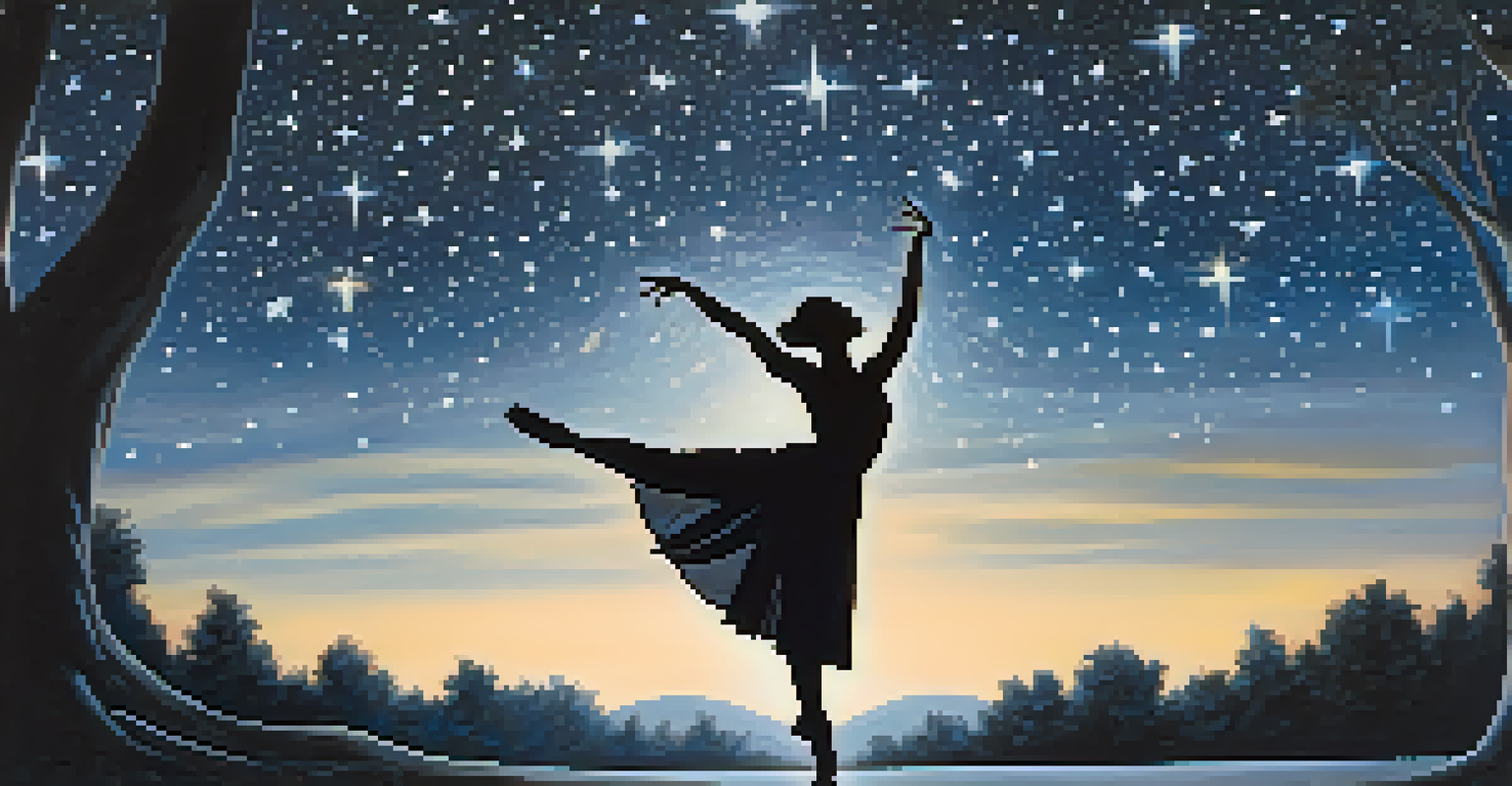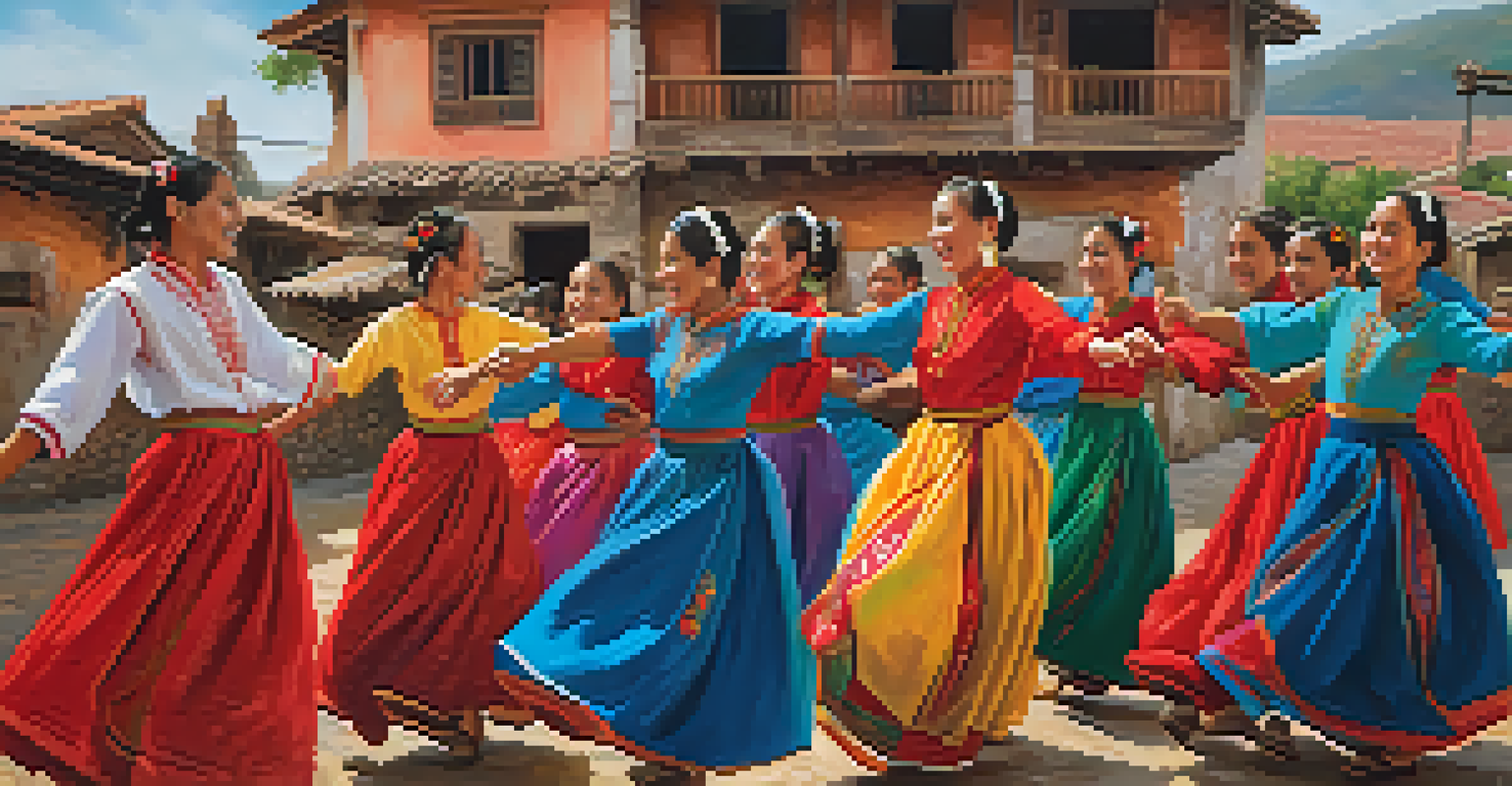Symbolic Meanings of Dance in Romantic Poetry and Prose

The Dance as a Metaphor for Love and Connection
In Romantic poetry, dance often symbolizes the profound connection between lovers. It reflects the idea that love transcends words, allowing emotions to be expressed through movement. For instance, when poets describe a couple dancing, it evokes images of harmony and unity, illustrating the deep bond they share.
Dance is the hidden language of the soul.
This metaphorical use of dance can also highlight the joys and struggles of romantic relationships. Just as a dance requires coordination and trust, so does love. When poets describe a couple’s missteps or graceful movements, they capture the complexities of intimacy, showcasing how love can be both exhilarating and challenging.
Moreover, dance in Romantic literature serves as a bridge between the physical and emotional realms. It allows characters to express their feelings in a visceral way, making the reader feel the intensity of their experiences. This embodiment of emotion through dance invites readers into the characters' world, enhancing their connection to the narrative.
The Connection Between Nature and Dance
Nature plays a crucial role in Romantic poetry, and dance often serves as a way to connect with the natural world. Poets frequently depict characters dancing in lush landscapes, symbolizing a unity with nature. This imagery reflects the Romantic ideal of finding beauty and inspiration in the wild, untamed aspects of the earth.

When dancers twirl amidst blooming flowers or under starlit skies, it illustrates the theme of freedom and spontaneity. It’s as if the dancers become one with their surroundings, echoing the Romantic belief that nature is a source of solace and inspiration. This connection emphasizes the importance of nature in understanding human emotions.
Dance Symbolizes Love and Connection
In Romantic poetry, dance represents the profound emotional bond between lovers, expressing their feelings beyond words.
Additionally, dance can represent the cyclical rhythms of life found in nature. Just as seasons shift, so do the emotions tied to love and longing. By intertwining dance with the natural landscape, poets create a rich tapestry that reflects the harmony between human experience and the larger world, allowing readers to see their own lives mirrored in the dance of nature.
The Role of Dance in Expressing Freedom
Dance in Romantic poetry often symbolizes the quest for personal freedom and liberation. Characters who break into dance are usually shedding societal constraints, embracing their true selves. This notion resonates deeply with the Romantic ideal of individuality, where personal expression is revered.
The dance is a poem of which each movement is a word.
When poets describe scenes of spontaneous dancing, it conveys a sense of joy and release. This freedom to move without restraint parallels the desire for emotional autonomy in relationships. By highlighting these moments, poets invite readers to reflect on their own struggles for freedom and the transformative power of self-expression.
Moreover, dance can be a rebellion against the rigid norms of society. In a world that often stifles creativity and passion, the act of dancing becomes a bold statement of defiance. This connection between dance and freedom underscores the Romantic belief in the necessity of breaking free from societal expectations to embrace one’s authentic self.
Dance as a Symbol of Transformation
Transformation is a prevalent theme in Romantic literature, and dance often embodies this idea. Poets frequently depict characters whose emotions evolve through the act of dancing. This transformation can signify personal growth, healing, or the awakening of deeper feelings, illustrating how movement can catalyze change.
For instance, a character who initially dances with hesitation might gradually find confidence and joy as the dance unfolds. This progression mirrors the journey of love itself, where initial uncertainty can give way to profound connection. Through dance, poets convey the idea that love has the power to transform individuals and relationships.
Nature Enhances Dance Imagery
Poets often depict dance in natural settings, symbolizing freedom and the deep connection between human emotions and the natural world.
Additionally, dance can symbolize the passage of time and the evolution of relationships. Just as dances change rhythm and form, so do the dynamics between lovers. By exploring these transformations through dance, Romantic poets invite readers to consider their own experiences of change, both in love and in life.
The Interplay of Dance and Emotion
In Romantic poetry, the interplay between dance and emotion is a powerful theme. Dancing is often portrayed as a direct expression of one's inner feelings, transcending the limitations of language. Poets skillfully describe how movement can capture the essence of joy, sorrow, and longing, making the emotional experience palpable for readers.
For example, a joyous dance may evoke feelings of elation and celebration, while a somber dance can reflect despair and heartache. This emotional resonance allows readers to connect deeply with the characters, as they witness how dance becomes a conduit for expressing complex emotions. It’s this rich exploration of feelings that makes Romantic literature so relatable.
Moreover, the rhythm and flow of dance mirror the complexities of human emotions. Just as a dance can shift from fast to slow, emotions can oscillate between extremes. By illustrating this connection, Romantic poets remind readers that emotions are not static; they ebb and flow, much like the movements of a dance, creating a dynamic tapestry of human experience.
The Influence of Folk Traditions on Romantic Dance Imagery
Folk traditions significantly impacted the portrayal of dance in Romantic poetry and prose. Many poets drew inspiration from local customs and dances, which added a rich cultural layer to their work. This incorporation of folk elements not only celebrated community but also highlighted the universal nature of dance as a form of expression.
By weaving traditional dances into their narratives, Romantic poets connected readers to the collective human experience. These dances often conveyed themes of love, celebration, and communal bonds, making them relatable to a wide audience. This connection to cultural roots emphasizes the importance of shared experiences in understanding the human condition.
Dance Reflects Personal Transformation
Through dance, characters in Romantic literature undergo significant emotional changes, illustrating how movement can catalyze personal growth and healing.
Furthermore, the use of folk dance imagery serves to ground the lofty ideals of Romanticism in real-world experiences. It creates a contrast between the idealized notions of love and the tangible, often messy realities of human relationships. This blend of the traditional and the romantic enriches the narrative, providing depth and authenticity to the portrayal of dance.
The Legacy of Dance in Romantic Literature
The symbolic meanings of dance in Romantic poetry and prose have left a lasting legacy in literature. This rich tradition continues to inspire contemporary writers and artists, who draw on the themes of love, freedom, and transformation. By examining how dance is used symbolically, we gain insights into the broader human experience.
Modern interpretations of dance in literature often echo the Romantic emphasis on emotion and connection. Writers today still explore the transformative power of dance, reflecting the ongoing relevance of these themes. This continuity highlights how the symbolism of dance transcends time and remains a vital expression of human feelings.

Ultimately, the legacy of dance in Romantic literature invites readers to reflect on their own relationships with movement and emotion. Whether through the joy of a shared dance or the solitude of a personal journey, the themes explored in Romantic poetry continue to resonate. This enduring connection between dance and the human experience reminds us of the beauty and complexity of our emotions.